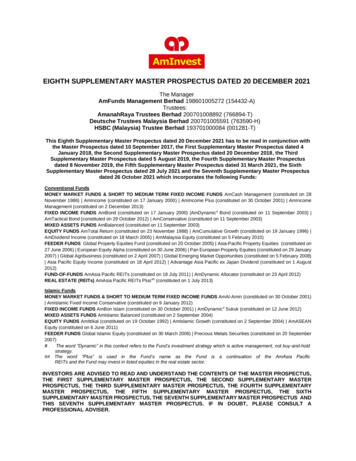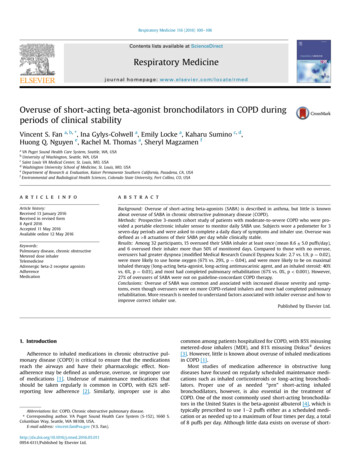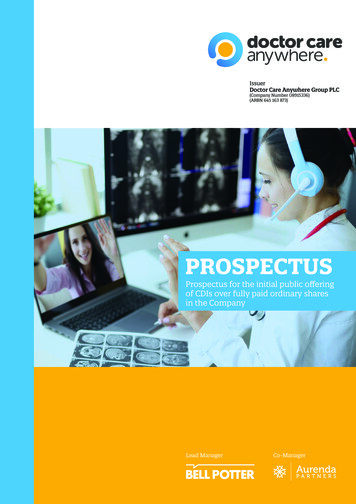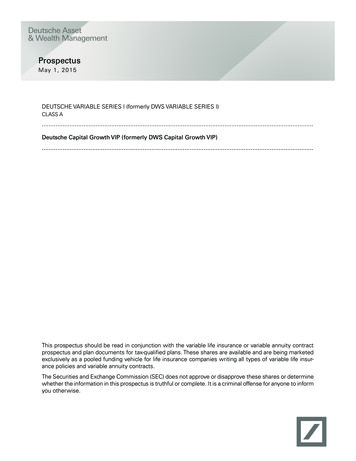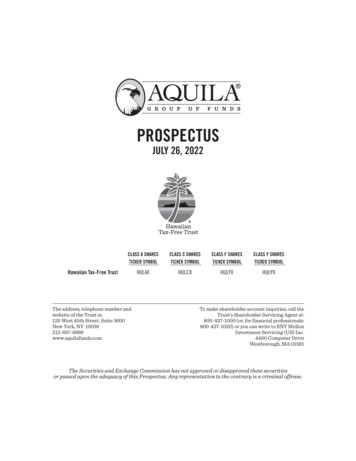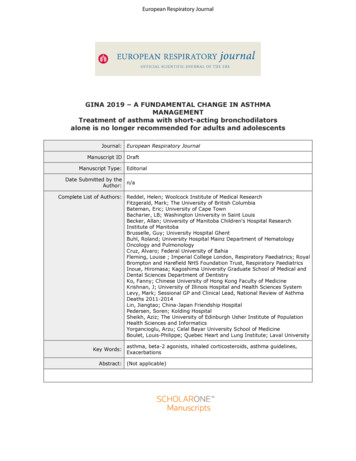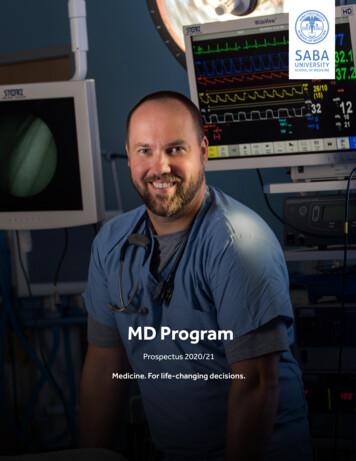
Transcription
Saba University School of MedicineMD ProgramProspectus 2020/21Prospectus 2020/21Medicine. For life-changing decisions.1
299% USMLE Step 1first time pass rate(2015-2019 average)
Welcome to Saba University04Accreditations and Approvals08Why Saba UniversityA Record of SuccessCampus FacilitiesBasic Sciences CurriculumSemester 1Semester 2Semester 3Semester 4Semester 5Clinical RotationsResearchClinical ExperienceAdmissionsApplication RequirementsTuition and FeesHousingOn Campus HousingSaba at a GlanceSome of the illustrations used in this Prospectus may be of facilities other thanSaba’s so as to dramatize the ospectus 2020/21Off Campus Housing06Saba University School of MedicineContents
4Welcome toSaba UniversitySchool of MedicineDear prospective students,Becoming an MD is a commitment. As you plan your medical education, Saba University Schoolof Medicine is delighted that you are considering studying with us.Since its founding in 1992, Saba University has had a vision to provide a medical curriculum thatnot only provides students with the knowledge they need to become excellent MDs, but thecompassion to treat all patients with dignity and respect.Our focus is education—that’s something you will notice from the moment you set foot oncampus. Our Basic Sciences and Clinical curriculum is second-to-none, with small class sizesand outstanding faculty. We carefully manage our program to assure that when you return foryour clinical experience at teaching hospitals in the U.S. and Canada there will be the rightnumber of high quality clerkships.Saba University School of Medicine is extremely proud of the outstanding performance of Sabastudents on the USMLE Step 1 and Step 2 exams, our high residency placement rate and thefact that the U.S. Department of Education has approved our students to obtain U.S. FederalDirect student loans. Our Admissions Department is delighted to answer any questions youhave about our program. Call or e-mail us at any time.Throughout this viewbook, you will have the opportunity to learn more about our tailor-madecurriculum, life at Saba University as well as more about living in the Caribbean.Welcome to Saba University.Joseph Chu.MD, MPH, PresidentSome of the illustrations used in this Prospectus may be of facilities other than Saba’s so as to dramatize the experience.
Saba University School of MedicineProspectus 2020/215
6
Saba University School of MedicineWhy SabaUniversity?A Record of SuccessDistinguished facultyU.S. State RecognitionSmall, intimate class sizesBetween 2015 and 2019, the first time passrate averaged 99% on the USMLE Step 1a consistently strong performance.Saba University is one of the fewinternational medical schools approved bythe key licensing boards of California, NewYork and Florida, meaning our graduatesare eligible to practice anywhere in the USand Canada.Financial AidSaba University has been approved by USDepartment of Education to participatein the William D. Ford Federal DirectLoan Program.Affordable feesOur classes are made up of approximately90 students to encourage a uniquely closerelationship between student and teacher.State-of-the-art campusModern classrooms with key technologicalfeatures, an interactive learning facility,a fully equipped Clinical Skills TrainingCenter and a fully equipped test center forsimulating the actual test conditions of theUSMLE Step 1.Saba in the CaribbeanOur campus is located on the island of Saba,known for its excellent diving opportunities,fishing and eco-tourism.Prospectus 2020/21Our fees are comparably lower than thoseoffered by US and Canadian medicalschools. We also offer one of the mostaffordable programs in the Caribbean.All our faculty members are experiencedteachers holding an advanced degree ordoctorate in their field.7
8
Saba University School of MedicineSABAProspectus 2020/21Accreditationsand Approvals9
10Accreditationsand ApprovalsAccreditationsSaba University’s program of medicine is accredited by theNVAO (in Dutch: Nederlands-Vlaamse Accreditatieorganisatie),an internationally recognized accreditation system.Approvals: California, New York and FloridaSaba University School of Medicine is one of the few international medical schools with approvals in the key states of New York,California and Florida. These states mandate institutional reviewand approval prior to granting access to clerkship opportunitiesin their respective states. By virtue of these approvals, studentswho successfully complete the requisite licensing examinationsare eligible to practice medicine in Canada, Puerto Rico and all 50U.S. states.Approved for US Federal LoansSaba University School of Medicine has been approved by theUnited States Department of Education for participation in theWilliam D. Ford Federal Direct Loan Program. Qualified citizensand permanent residents of the United States may be eligible toreceive funding from the Direct Loan programs to help pay forthe full cost of their education.
Saba University School of MedicineThe standards are pretty high at Saba,particularly in comparison to other Caribbeanmedical schools. That’s why Saba has such ahigh match and success rate.Malika Hudani, MD Family MedicineProspectus 2020/2111
12
Saba University School of MedicineSABAProspectus 2020/21A Recordof Success13
14A Recordof SuccessThe most important measures of success on the SabaUniversity MD program are our students’ exam results andthe appointments obtained by our graduates.USMLE Step 1Saba students perform exceptionally well on the USMLE exam.Each year, virtually every Saba student passes the USMLE Step 1on their first attempt. Between 2015 and 2019, the first time passrate averaged 99% - a consistently strong performance.Graduate appointmentsEach year, Saba University School of Medicine graduatesobtain ACGME-accredited residency appointments at renownedteaching hospitals and leading medical centers across the US andCanada. In 2019 Saba University students took up appointmentsat facilities including: Florida State University College of Medicine – Orlando (FL) John Hopkins University – Baltimore (MD) Indiana University School of Medicine – Jasper (IN)McMaster University – Niagara, ON (CAN)University Washington School of Medicine – Seattle (WA)University of Toronto ON (CAN)
Saba University School of MedicineI looked at the USMLE stats, match rate,cost and class size and chose Saba. I felt wellsupported, as there was a large percentage ofCanadians in my class; I was in good company.Keil Elliott, MD-Resident in Family Medicine at McMaster UniversityProspectus 2020/2115
16Campus FacilitiesThe Saba University campus is fully equipped with classrooms, laboratories,a medical library, administrative offices, faculty offices, a fitness centre and arange of student support services.Modern classroomsOur classrooms are fully air conditioned andcome equipped with state-of-the-artteaching aids (LCD projectors, flat screendisplays and multimedia capability).Additional facilities include a fully equippedClinical Skills Training Center and a fullyequipped test center for simulating theactual test conditions of the USMLE Step 1.LaboratoriesThe gross anatomy laboratory is suppliedwith human cadavers for dissection andradiological materials to conduct detailedstudies of the human body. A modernmicrobiology laboratory provides studentswith the opportunity to acquire in-depthknowledge of the fundamentals ofinfectious disease.W.F.M. Johnson Medical LibraryThe W.F.M. Johnson Library providesstudents with a central location for medicalliterature, reference books and acomputer center. Students have access to awide variety of hard-copy journals as well asonline access to full text journals andbibliographic information through theuniversity’s subscriptions to major researchpublications and educational webservices. The library contains a learningresource center supplied with tutorialmaterials, videotapes, models andspecialized computer programs.
Saba University School of MedicineProspectus 2020/2117
18
Saba University School of MedicineProspectus 2020/21Basic SciencesCurriculum19
20CurriculumBasic Sciences Curriculum (Semesters 1-5)SEMESTER 1Med 512 – Human Body Structure & FunctionThis course explores basic gross human anatomy,allowing students to understand the relationshipbetween anatomical structure and function.Through lectures, regional dissections of cadaversand evaluation of radiographs (including CT andMRI), students acquire a basic knowledge of thenormal gross structure, functional and clinicalanatomy of organs and systems of the adulthuman body, including the brain and spinal cord.Computer-based tutorial programs and structuredreviews are used to supplement the lectures andlabs. (15 credits: 231 hrs.)MED 514 – Human Histology and PhysiologyThis course examines the microanatomy ofcells, tissues and organs as well as the basiccomponents of human physiology. Lecturesillustrate the microstructure of major tissues andorgans in relation to their function.This program presents the molecular biologyand histology of normal cells, tissues and organsystems at various developmental functionalstages. Students learn how individual cellfunctions interact with one another and howsuch interactions are accomplished from thetissue levels to the organ levels.The course prepares students for an understandingof the normal (homeostasis) structure of systemsand furnishes the background for appreciatingpathological conditions.In addition, students learn how molecular buildingblocks are utilized for growth and differentiation,wound healing and tissue repair, defensemechanisms and transfer of hereditary characters.Physiology topics include the basic components ofall organ systems. (13 credits; 180 hrs.)MED 516 – Clinical Skills IThis is the first course in a five-part series thatfocuses on communication skills, eliciting thepatient’s history, performing a physical exam,and communicating their findings to healthcareprofessionals through oral presentations andwritten notes.In this course, students will learn and practice thefoundations of patient-physician communicationskills, including initiating the session, buildingthe relationship, exploration of problems,understanding the patient agenda and structuringthe consultation. Students will also learn the firststeps of eliciting the patient’s story in a patientcentered manner and the initial componentsof a physical exam.
Saba University School of MedicineIn addition, students will begin to develop theirskills documenting their findings in a patient note.(2 credits: 30 hrs.)SEMESTER 2MED 611 – Metabolism & NutritionThe biochemical pathways of living organisms arestudied with a focus on metabolic processes.Topics include pathways linking nutritional intakeand energy yielding processes as well as theapplication of underlying principles discussed inScientific Foundations (First Semester – First Block).Broad content includes a study of the chemistry andreactions of constituents of living matter, includingcarbohydrates, lipids, proteins, nucleic acids,vitamins, coenzymes and minerals.In addition the chemistry and regulation of thereactions and processes of whole organisms will beexamined including: endocrinology, enzymology,nutrition, intermediary metabolism and biochemicalmechanisms involved in select disease states. (9credits; 133 hrs.)This course provides students with anunderstanding of the principles and concepts uponwhich current clinical genetic practice (diagnosis,This course covers the genetics of humanpopulations and introduces recent and ongoingdiscoveries so that their future applications maybe understood. (4 credits; 65 hrs.)MED 613 – Infection/Defense/ResponseThis course considers the characteristics andproperties of microorganisms, their role in thedisease processes and selected aspects ofdiagnosis and treatment of infectious disease.Other topics include the basic principles ofbacteriology, mycology, parasitology, virology,immunology and microbial genetics, includingcultural characteristics and pathogenic propertiesof medically important species of bacteria, fungiand viruses.This course covers the basic immunologicconcepts of the cells and humoral products of theimmune system. Lectures include the molecularbiology and genetics of antigen recognition andimmunoglobulin production plus the characteristicsand detection of antigen-antibody reactions.Prospectus 2020/21MED 612 – Genetics and Developmenttreatment and genetic counselling) is based. Italso incorporates human development, allowingstudents to understand the relationship betweenembryonic development, in terms of human bodystructure and function, and the underlyinggenetic mechanisms of congenital abnormalities.The approach is to correlate these basic concepts21
22with clinical manifestations of disease, theimmunopathologic mechanisms of hypersensitivity,autoimmunity, transplantation, tumor immunology,hematology, reproduction, infectious diseases,immunodefiency and pharmacotherapy.(12 credits; 186 hrs.)MED 614 – Medical EthicsThis course provides a comprehensive study ofthe legal and ethical issues involved in the practiceof medicine. Medical ethics will consist of a seriesof seminars devoted to discussion of varioustopics such as disclosure, confidentiality, informedconsent and death and dying.The inclusion of ethics case discussions will allowstudents to discuss and debate ethical scenarios.Legal cases posing dilemmas that relate to eachcase will be presented, along with abstract materialto facilitate conceptual and ethical analysis. (2credits; 37 hrs.)MED 616 – Clinical Skills IIAfter a review of the skills developed in Clinical SkillsI, students will learn additional components of apatient-centered history.This includes explaining and planning a treatmentplan and communication skills in specific situationsincluding delivering bad news, cultural andsocial diversity, and demonstration of empathy.Instruction on the history continues with the pastmedical history, family history, social history and acomplete review of systems. Students will also learnto perform a complete screening physical exam andwill continue to develop documentation skills withoral presentations and the patient note.3 credits; 44 hrs.)MED 619 – Research Curriculum –Evidence-based MedicineStudent will have an opportunity to developresearch skills related to evidence-based medicine(EBM). Students will be introduced to concepts ofresearch analysis and critical thinking.At the end of this course, students will be ableto identify and frame a clinical question basedon therapy, diagnosis, prognosis or etiology;develop a focused search strategy to identifyarticles that best answer the clinical question; findthe appropriate medical database; and criticallyappraise articles for validity. Students will berequired to independently utilize various types ofEBM resources.Students will use technological resources that areavailable online and in the Saba University Schoolof Medicine library. Skills acquired in this coursewill allow students to successfully complete theresearch module, Research: Literature Review andAnalysis (RLRA). (1 credits; 19 hrs.)SEMESTER 3MED 714 – Neuroscience and Neurology(Weeks 1-15)This course will include an interdisciplinaryinvestigation of the pathology, physiologyand the gross and microscopic structure ofthe brain, spinal cord and nervous system ofhumans. Aspects of brain energy metabolism,neurotransmitter synthesis and degradation andpsychopharmacology are presented. This courseintegrates anatomical and physiological materialto assist the student in understanding commonneurological disease processes.
Saba University School of MedicineProspectus 2020/2123
24I had an amazing time. The island is beautiful,safe, and a perfect place for studying. It gave methe ability to focus on medical school without anydistractions. I also liked the fact that I could makeappointments with my professors for that sameday and oftentimes, I could just walk into theiroffice and get the help I needed.Erika Leung, Saba student.Erika completed a Geriatric Fellowship at Beth Israel DeaconessHospital in Boston, a Harvard Medical School teaching hospital
In addition, there will be integration of conceptslearned in MED 716 - Clinical Skills III, MED 715 –System-Based Medicine I and MED 719 – BehavioralMedicine. Each of these interactive sessions willinclude group problem-solving exercises andcritical appraisal of the primary literature. Studentswill present different aspects of contemporaryscientific and medical literature including thebackground, current understanding and futuredirections. (10 credits; 143 hrs.)MED 715 – Systems & Disease I (Introduction/Endocrine) (Weeks 1-15)Basic principles of human physiology, pathologyand pharmacology are studied followed by aninvestigation of the endocrine system. This courseemploys the endocrine system as a transition tosemesters 4 and 5 where the remainder of thesystems will be discussed. As with the rest ofthe Systems & Disease courses, each system willbegin with a detailed review of pertinent humanbody structure and function as well as cell/tissuestructure and function.MED 716 – Clinical Skills III (weeks 4-12)After a review of the skills developed in ClinicalSkills I & II, students will learn to communicatein a patient-centered manner in other specificsituations including patients with mental illness,obtaining information from other caregivers,providing advocacy and support and medicallyunexplained symptoms.Students will continue to refine their ability toobtain a complete history and conduct a completephysical exam. Students will also refine their abilityto obtain a complete history and physical exam in apatient-centered manner and will begin to learn toobtain a problem-focused history. Documentationskills will focus on the complete history and physicalexam with oral presentations and the patient note.(3 credits; 40 hrs.)MED 719 – Behavioral MedicineThis course presents the basic principles ofhuman behavior including biological, social andcultural substrates. Both normal and abnormalbehavior theories will be included in an overviewof personality development. Workshops willcover areas such as interviewing techniques,death education, human sexuality andpsychophysiological disorders including stressmanagement and biofeedback.Additional lectures present various classes ofpsychotropic drugs and their indications. Thecourse will also address the fundamental principlesof the distribution of diseases and their causesin human populations. Students will learn howto conduct epidemiologic investigations, howto critically review medical literature and how touse this information in a clinical environment.Students will acquire a basic level of proficiency inepidemiologic principals, biostatistics and be ableto apply these in clinical practice.(8 credits; 127 hrs.)Prospectus 2020/21This will be followed by the presentation of theindividual systems in detail, including relevantpathology, physiology, pharmacology, clinical skillsand clinical presentations of disease. All content willbe integrated. (11 credits; 158 hrs.)Saba University School of MedicineLaboratory exercises will provide slides anddissection of the human brain, spinal cord andrelevant structures. Students will be introducedto modern methods of neuroimaging, includingCT scans and MRI. Weekly sessions will introducestudents to the relationship between basic scienceand clinical medicine with emphasis on diagnostics,therapeutics and disease causation.25
26SEMESTER 4MED 811 – Systems & Disease II (Repro/GI/PedsThe Systems & Disease series of courses begin witha detailed review of pertinent human body structureand function as well as cell/tissue structure andfunction. This will be followed by the presentationof the individual systems in detail, including relevantpathology, physiology, pharmacology, clinical skillsand clinical presentations of disease.All content will be integrated. Additionally, ClinicalCorrelate sessions will introduce students tothe relationship between individual systems,pharmacology and clinical medicine with emphasison diagnostics, therapeutics and disease causation.These sessions will include didactic instruction,group problem-solving exercises and criticalappraisal of the primary literature. This coursecovers the reproductive and gastrointestinalsystems and pediatrics. (13 credits; 196 hrs.)& Disease, concentrating on the integumentary,cardiovascular, respiratory, renal and neurologicalsystems. Students will further develop theirability to complete a problem-focused history andphysical exam. Documentation skills will focus onthe complete history and physical exam with oralpresentations and the patient notes for both acomplete history and physical exam and a focusedpatient visit. (6 credits; 96 hrs.)SEMESTER 5ED 911 – Systems & Disease V (Heme/Immune/Integument/MSK/Multisystem)This course covers the hematologic, immune,integumentary and musculoskeletal systems aswell as multisystem disease. It follows the structuredescribed in MED 811 – Systems & Disease II.(12 credits; 183 hrs.)MED 916 – Clinical Skills VMED 816 – Clinical Skills IVAfter a review of the skills developed in ClinicalSkills I – IV, students will continue to develop theircommunication skills and ability to perform acomplete history and physical exam. Physical examskills will be reinforced by more in-depth instructionin the physical exam skills that correspond tothe systems studied in Systems & Disease V,concentrating on the gastrointestinal, endocrine,reproductive and musculoskeletal systems.After a review of the skills developed in ClinicalSkills I – III, students will continue to developtheir communication skills and ability to performa complete history and physical exam. Physicalexam skills will be reinforced by more in-depthinstruction in the physical exam skills thatcorrespond to the systems studied in SystemsStudents will further develop their ability tocomplete a problem-focused history and physicalexam. Documentation skills will be furtherdeveloped with focused patient visits, withadditional instruction on medical order writing,diagnostic decision-making and prescriptionwriting. (3 credits; 44 hrs.)MED 812 – Systems & Disease III (CV/Resp/RenalThis course covers the cardiovascular, respiratoryand renal systems, and follows the structuredescribed in MED 811 – Systems & Disease II. (13credits; 199 hrs.)
Saba University School of MedicineProspectus 2020/2127
28
ELECTIVE COURSES (SEMESTER 1-5)This course utilizes daily live lectures and othermaterials to provide a structured, integrated reviewof the basic sciences. An emphasis is placed onunderstanding of disease processes and clinicalproblem solving. Students attend daily live lectures.Students at Saba University are invited to takeelective courses during the first five semesters.The objective of an elective course is to provide thestudent with a structured, in depth experience in asubject matter that will contribute to the student’sbasic science knowledge base and promotescientific inquiry skills.Early in the course students are given a diagnosticpre-test to help identify problem areas andindividualize learning goals. At the end of the coursestudents are administered a full-length, simulatedcomprehensive exam. (16 credits: 246 hrs.)MED 919 – Research Curriculum –Critical AppraisalStudents will participate in the critical appraisalof contemporary medical literature, includingpublications representing various study designs aswell as the incorporation of basic science principles.Selected primary literature will range frompreclinical investigation through the various phasesof clinical trials.Electives include: MED 913 – Epidemiology andPreventative MedicineRESEARCH PROJECTThis elective allows the student to apply theprinciples of epidemiologic investigation to anindependent clinical research project. Specialattention is given to projects that will contributeto the healthcare needs and statistical data baseof the island of Saba. The student is expectedto prepare a written report and give an oralpresentation. (1 or 2 credits)MED 923 – Independent Research ElectiveThis elective allows the student to participate in astructured research project at the Saba UniversityResearch Center. Students will participate inongoing research projects with 1:1 facultysupervision or may propose their own project. Thestudent is expected to prepare a written report aswell as an oral presentation. (2 credits)Prospectus 2020/21Templates such as PICOT (population, intervention,comparison, outcome and time) will be introducedand utilized. This course will be integrated with thecontent presented in MED 911 – Systems & DiseaseV. Skills acquired in this course will allow studentsto successfully complete the research module,Research: Literature Review and Analysis (RLRA).(1 credits; 16 hrs.)Saba University School of MedicineMED 918 – Foundations of Clinical Medicine29
30
Saba University School of MedicineClinical RotationsProspectus 2020/2131
32ResearchThe medical world is changing rapidly. Research at Saba University School of Medicineand its integration into its program of medical education is designed to support criticalthinking and the application of scientific methodology.Prior to beginning their formal clinicaltraining, students are required to completea research module. In this required researchmodule, students will: Choose a current and complex medicalcare question Develop an actionable hypothesis Research published literature Critically assess their findings underthe guidance of a faculty mentorThe research module culminates with awritten paper in which students presenttheir findings and formulate conclusionswhich are evaluated by a committeecomposed of faculty and deans.In addition to the required researchelements of the curriculum, Saba Universitystudents are actively encouraged to pursueresearch projects independently and inconjunction with faculty members duringthe basic sciences and clinical medicineportions of their education.Each semester the school affords studentsand faculty the opportunity to publish andpresent their research projects to theirpeers at the university.The university also supports the publicationand presentation of student and facultyresearch projects in various journals andother recognized forums.The Research CommitteeThe Research Committee, consisting ofuniversity faculty members, evaluatesall proposals for research projects to beconducted at the university. The committeereviews projects in the context of thedesirability/feasibility of the proposal andthe soundness of the experimental design.Institutional Review BoardIn addition to the Research Committee,the Institutional Review Board for HumanSubjects (IRB) is responsible for the safetyof human subjects. Its role is to see that: All elements of “informed consent”as defined by the National Institutesof Health of the United States havebeen met. The subjects will not be placed at risk. All subjects are fully aware of anyconditions to which they maybe exposed.The IRB is made up of three members ofthe faculty and the Chief Medical Officer ofSaba. No research project, clinical study orinvestigation that involves human subjectswill be conducted in university facilitieswithout approval of both the ResearchCommittee and the IRB.
Saba University School of MedicineClinical ExperienceDuring semesters 6 to 10, you will have the opportunity to apply your theoretical knowledgeto a patient’s bedside, enabling you to understand how critical decisions are made in themedical world.Hospital affiliations in the United States aredivided into major geographic areas: East,Southeast and the Midwest. Although 95%of all Saba University students completetheir clinical clerkships in the United States,clerkships outside the United States may berequested by a student.The student should organize andsubmit the details to the Office of ClinicalMedicine for approval at least three monthsin advance.Required ClerkshipsElective ClerkshipsThird-year students complete coreclerkships in Surgery, Internal Medicine,Pediatrics, Psychiatry, and Obstetricsand Gynecology.In the fourth year, students choose amongelective clinical clerkships based upon theirprojected medical specialty.Saba University graduates have participated in elective clerkships in Great Britain,Ireland, Israel, Canada, Australia, India,Dutch Caribbean, Africa, Central Americaand Bosnia.WeeksHighly recommended electives include:Internal Medicine12CardiologyNeurologySurgery12Family MedicinePathologyObstetrics and Gynecology6DermatologyPlastic SurgeryPediatrics6Emergency otal42Intensive Care MedicineVascular SurgeryProspectus 2020/21Specialty33
34
Saba University School of MedicineAdmissionsProspectus 2020/2135
36AdmissionsGetting startedSaba has a rolling admissions policy so candidates are eligiblefor admission throughout the year. Candidates may apply foradmission up to a year in advance of the semester they plan tomatriculate. Applicants are encouraged to apply as early inadvance as possible so as to reserve a spot in an upcoming term.AdmissionsSaba University has three intakes per year: September, Januaryand May.Since the number of students in each class is limited and theapplication pool is competitive, the early applicants will have abetter chance of securing a place in the semester of their choice.Completed applications are reviewed and evaluated by thePre-Screening Committee. Those with incomplete applicationswill be notified, as will unqualified applicants. Applicants areselected for interview on the basis of the candidate’s ability tomeet the challenges of a rigorous medical school curriculum.Factors such as motivation, perseverance, scholastic
Saba University School of Medicine is one of the few internation-al medical schools with approvals in the key states of New York, California and Florida. These states mandate institutional review and approval prior to granting access to clerkship opportunities in their respective states. By virtue of these approvals, students

